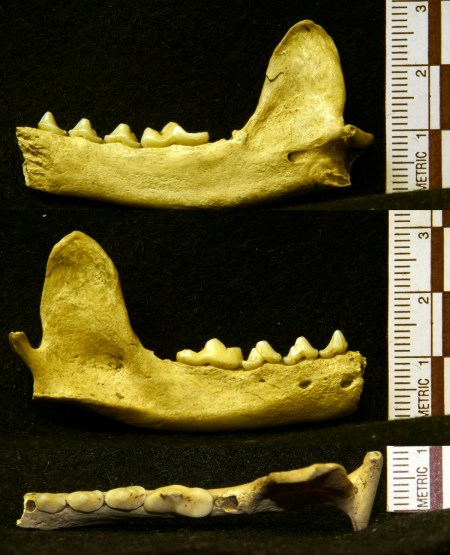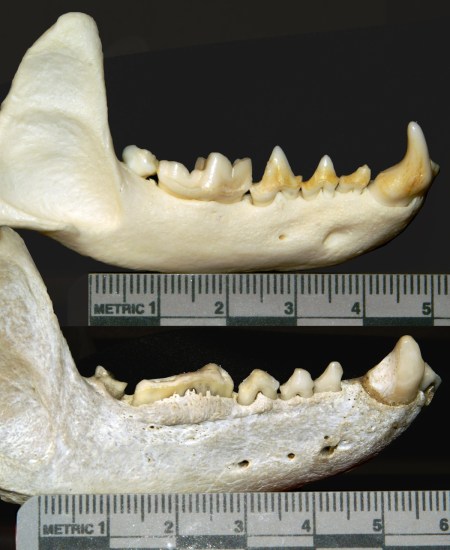On Friday I gave you this archaeological mystery object from Surrey to identify:
Jake immediately spotted that it was the mandible of a carnivore and ruled out a Cat because the teeth were wrong. General consensus leaned towards this being from a mustelid of some kind – which David Craven confirmed with the correct identification of Pine Marten Martes martes (Linnaeus, 1758).
Here is an image of a North American Otter mandible (sorry I didn’t have a Eurasian one to hand) and a Eurasian Badger mandible:
As you can see the Badger (bottom image) has a very robust mandible and very flat molars for mashing up earthworms (this one is particularly flat since it was an old individual, but all badgers have very flat molars). The Otter (top image) is the opposite, with several high cusps on its molars – all the better for dealing with slippery fish.
Pine Martens eat small mammals like squirrels, so perhaps it’s unsurprising that their teeth are quite similar in form to those of another small-mammal predator, the Red Fox (as noted by ObenedO). In fact, the Pine Martens’ taste for squirrel may be helping the Red Squirrel hold out in the face of the invading Grey Squirrels – it certainly seems to be happening in Ireland from reports I’ve heard. Unfortunately, Pine Martens don’t really have an impact on the Grey Squirrel population in England, since Pine Martens only occur in Scotland for certain and probably in Wales and the Lake District.
That said, the Pine Marten is showing signs of recovery after it finally received protection in the Wildlife and Countryside Act of 1981, just 93 years after protection was called for – the same 1888 article that calls for protection makes note of a record of a Pine Marten being killed 20 miles north of London in 1872. Clearly Pine Martens were still in the area south of London at some point between 1600-1850, as shown by this mystery object. It would be interesting to get a more accurate date for the archaeological remains associated with this specimen, to help get a better idea of how rapidly the southern range of the Pine Marten contracted.
I’ll leave you with an image of one of these beautiful and secretive (if voracious) mustelids:





damn! I was gonna comment on the lack of a grinding surface on the molar, but I was sure from the photo…
that should have been “was NOT sure from the photo” – meaning “I could be mistaken about a lack of a grinding surface on the m1”
I get you. That’s the trouble with photos – it’s so much easier to see these things when you have a specimen in your hands.
Encountered one up a tree in Scotland many years ago. They seem much bigger in the flesh.
Beautiful animal though.
We got a road-kill specimen from Ireland a year or so ago – absolutely beautiful animal.
did it chase you up a tree? 😉